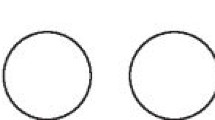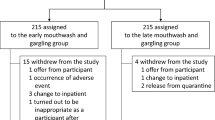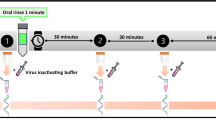Abstract
Introduction Virus particles in respiratory droplets and aerosols generated during medical/dental procedures are a potential source of SARS-CoV-2 cross infection. In the dental setting, oral decontamination could be an important adjunct to personal protective equipment and is recommended by a number of national COVID-19 guidance documents for dental settings.
Aim To assess the in vitrovirucidal activity of an oral povidone iodine (PVP-I) product against SARS-CoV-2.
Material and methods BETADINE gargle and mouthwash (1% PVP-I) was tested against SARS-CoV-2 virus under both clean and dirty conditions using a suspension assay based on EN14476 methodology. Virucidal activity of the product, undiluted and at 1:2 dilution, was tested at contact times of 15, 30 and 60 seconds. Viral titres were calculated using the Spearman-Kärber method and reported as median tissue culture infectious dose (TCID50/ml).
Results The undiluted product achieved >5 log10 reduction in viral titres compared to the control at 15, 30 and 60 seconds under both clean and dirty conditions. At a twofold dilution (0.5% PVP-I), the test product demonstrated >4 log10 kill at 15 seconds and >5 log10 kill at 30 and 60 seconds in both clean and dirty conditions.
Conclusion PVP-I gargle and mouthwash product, undiluted and at 1:2 dilution, demonstrated potent and rapid virucidal activity (≥4 log10 reduction of viral titre) in 15 seconds against SARS-CoV-2 in vitro. The PVP-I gargle and mouthwash product is widely available and could be readily integrated into infection control measures during dental treatment including pre-procedural oral decontamination.
Key points
-
Close contact and potential for aerosol generation increase risk of SARS-CoV-2 exposure during medical and dental procedures.
-
Pre-procedural mouth rinses are recommended as an additional measure to reduce cross-infection risk in dental settings.
-
PVP-I (1%) gargle and mouthwash showed 99.99% kill rate of SARS-CoV-2 in vitro within 15 seconds of contact in clean and dirty conditions.
-
The use of PVP-I-containing pre-procedural mouth rinse to reduce oral viral load could be recommended in addition to other protective measures.
Similar content being viewed by others
Log in or create a free account to read this content
Gain free access to this article, as well as selected content from this journal and more on nature.com
or
References
World Health Organisation. Interim recommendations on obligatory hand hygiene against transmission of COVID-19. 2020. Available online at https://www.who.int/publications/m/item/interim-recommendations-on-obligatory-hand-hygiene-against-transmission-of-covid-19 (accessed November 2020).
Wax R S, Christian M D. Practical recommendations for critical care and anaesthesiology teams caring for novel coronavirus (2019-nCoV) patients. Can J Anaesth 2020; 67: 568-576.
Morawska L, Cao J. Airborne transmission of SARS-CoV-2: The world should face the reality. Environ Int 2020; 139: 105730.
Wilson N M, Norton A, Young F P, Collins D W. Airborne transmission of severe acute respiratory syndrome coronavirus-2 to healthcare workers: a narrative review. Anaesthesia 2020; 75: 1086-1095.
Mick P, Murphy R. Aerosol-generating otolaryngology procedures and the need for enhanced PPE during the COVID-19 pandemic: a literature review. J Otolaryngol Head Neck Surg 2020; 49: 29.
Hoffmann M, Kleine-Weber H, Schroeder S et al. SARS-CoV-2 Cell Entry Depends on ACE2 and TMPRSS2 and Is Blocked by a Clinically Proven Protease Inhibitor. Cell 2020; DOI: 10.1016/j.cell.2020.02.052.
To K K-W, Tsang O T-Y, Yip C C-Y et al. Consistent detection of 2019 novel coronavirus in saliva. Clin Infect Dis 2020; 71: 841-843.
To K K, Tsang O T-Y, Leung W-S et al. Temporal profiles of viral load in posterior oropharyngeal saliva samples and serum antibody responses during infection by SARS-CoV-2: an observational cohort study. Lancet Infect Dis 2020; 20: 565-574.
Yoon J G, Yoon J, Song J Y et al. Clinical Significance of a High SARS-CoV-2 Viral Load in the Saliva. J Korean Med Sci 2020; DOI: 10.3346/jkms.2020.35.e195.
Peng X, Xu X, Li Y, Cheng L, Zhou X, Ren B. Transmission routes of 2019-nCoV and controls in dental practice. Int J Oral Sci 2020; 12: 9.
Centres for Disease Control and Prevention. Interim Infection Prevention and Control Guidance for Dental Settings During the Coronavirus Disease 2019 (COVID-19) Pandemic. 2020. Available at https://www.cdc.gov/coronavirus/2019-ncov/hcp/dental-settings.html (accessed November 2020).
Gandhi M, Yokoe D S, Havlir D V. Asymptomatic Transmission, the Achilles' Heel of Current Strategies to Control Covid-19. N Engl J Med 2020; 382: 2158-2160.
Bai Y, Yao L, Wei T et al. Presumed Asymptomatic Carrier Transmission of COVID-19. JAMA 2020; 323: 1406-1407.
Australian Dental Association. Managing COVID-19 Guidelines. 2020. Available at https://www.ada.org.au/Covid-19-Portal/Cards/Dental-Profesionals/Infection-Control/Transmission-Based-Precautions (accessed November 2020).
Challacombe S J, Kirk-Bayley J, Sunkaraneni V S, Combes J. Povidone iodine. Br Dent J 2020; 228: 656-657.
Vogt P M, Hauser J, Mueller S, Bosse B, Hopp M. Efficacy of Conventional and Liposomal Povidone-Iodine in Infected Mesh Skin Grafts: An Exploratory Study. Infect Dis Ther 2017; 6: 545-555.
Eggers M, Koburger-Janssen T, Eickmann M, Zorn J. In Vitro Bactericidal and Virucidal Efficacy of Povidone-Iodine Gargle/Mouthwash Against Respiratory and Oral Tract Pathogens. Infect Dis Ther 2018; 7: 249-259.
Kawana R, Kitamura T, Nakagomi O et al. Inactivation of human viruses by povidone-iodine in comparison with other antiseptics. Dermatology 1997; 195 Suppl 2: 29-35.
Kariwa H, Fujii N, Takashima I. Inactivation of SARS coronavirus by means of povidone-iodine, physical conditions and chemical reagents. Dermatology 2006; 212 Suppl 1: 119-123.
Eggers M, Eickmann M, Zorn J. Rapid and Effective Virucidal Activity of Povidone-Iodine Products Against Middle East Respiratory Syndrome Coronavirus (MERS-CoV) and Modified Vaccinia Virus Ankara (MVA). Infect Dis Ther 2015; 4: 491-501.
Anderson D E, Sivalingam V, Kang A E Z et al. Povidone-iodine demonstrates rapid in-vitro virucidal activity against SARS-CoV-2, the virus causing COVID-19 disease. Infect Dis Ther 2020; 9: 669-675.
Bidra A S, Pelletier J S, Westover J B, Frank S, Brown S M, Tessema B. Rapid In-Vitro Inactivation of Severe Acute Respiratory Syndrome Coronavirus 2 (SARS-CoV-2) Using Povidone-Iodine Oral Antiseptic Rinse. J Prosthodont 2020; 29: 529-533.
World Health Organisation. WHO R&D Blueprint COVID 19: Experimental Treatments. 2020. Available at https://www.who.int/docs/default-source/coronaviruse/covid-classification-of-treatment-types-rev.pdf (accessed November 2020).
European Committee for Standardization. Chemical disinfectants and antiseptics. Quantitative suspension test for the evaluation of virucidal activity in the medical area. Test method and requirements (Phase 2/Step 1). 2015. Available at https://infostore.saiglobal.com/preview/98702935197.pdf (accessed November 2020).
Spearman C. The method of 'right and wrong cases' ('constant stimuli') without Gauss's formulae. Br J Psychol 1908; 2: 227-242.
Kärber G. Beitrag zur kollektiven Behandlung pharmakologischer Reihenversuche. Archiv Exper Pathol Pharmakol 1931; 162: 480-483.
Hassandarvish P, Tiong V, Sazaly A B et al. Povidone iodine gargle and mouthwash. Br Dent J 2020; 228: 900.
Kanagalingam J, Feliciano R, Hah J H, Labib H, Le T A, Lin J-C. Practical use of povidone-iodine antiseptic in the maintenance of oral health and in the prevention and treatment of common oropharyngeal infections. Int J Clin Pract 2015; 69: 1247-1256.
Fallahi H R, Keyhan S O, Zandian D, Kim S G, Cheshmi B. Being a front-line dentist during the Covid-19 pandemic: a literature review. Maxillofac Plast Reconstr Surg 2020; 42: 12.
Harrel S K, Molinari J. Aerosols and splatter in dentistry: a brief review of the literature and infection control implications. J Am Dent Assoc 2004; 135: 429-437.
Gui D, Pepe G, Magalini S. Just one more hygiene practice in COVID-19. Eur Rev Med Pharmacol Sci 2020; 24: 3438-3439.
Burton M J, Clarkson J E, Goulao B et al. Use of antimicrobial mouthwashes (gargling) and nasal sprays by healthcare workers to protect them when treating patients with suspected or confirmed COVID-19 infection. Cochrane Database Syst Rev 2020; DOI: 10.1002/14651858.CD013626.pub2.
Burton M J, Clarkson J E, Goulao B et al. Antimicrobial mouthwashes (gargling) and nasal sprays to protect healthcare workers when undertaking aerosol-generating procedures (AGPs) on patients without suspected or confirmed COVID-19 infection. Cochrane Database Syst Rev 2020; DOI: 10.1002/14651858.CD013628.pub2.
Ather A, Patel B, Ruparel N B, Diogenes A, Hargreaves K M. Coronavirus Disease 19 (COVID-19): Implications for Clinical Dental Care. J Endod 2020; 46: 584-595.
O'Donnell V B, Thomas D, Stanton R et al. Potential role of oral rinses targeting the viral lipid envelope in SARS-CoV-2 infection. Function 2020; DOI: 10.1093/function/zqaa002.
Mady L J, Kubik M W, Baddour K, Snyderman C H, Rowan N R. Consideration of povidone-iodine as a public health intervention for COVID-19: Utilization as "Personal Protective Equipment" for frontline providers exposed in high-risk head and neck and skull base oncology care. Oral Oncol 2020; 105: 104724.
Kirk-Bayley J, Challacombe S, Sunkaraneni S, Combes J. The Use of Povidone Iodine Nasal Spray and Mouthwash During the Current COVID-19 Pandemic May Protect Healthcare Workers and Reduce Cross Infection. 2020. Available online at https://papers.ssrn.com/sol3/papers.cfm?abstract_id=3563092 (accessed November 2020).
Fine P D. A clinical trial to compare the effect of two antiseptic mouthwashes on gingival inflammation. J Hosp Infect 1985; 6 Suppl A: 189-193.
Eggers M, Koburger-Janssen T, Ward L S, Newby C, Müller S. Bactericidal and Virucidal Activity of Povidone-Iodine and Chlorhexidine Gluconate Cleansers in an In Vivo Hand Hygiene Clinical Simulation Study. Infect Dis Ther 2018; 7: 235-247.
Acknowledgements
This study and editorial support for the publication of this manuscript was funded by Mundipharma Singapore Holding Pte Limited. The results of this study were reported in abbreviated form in a letter to the editor published in the British Dental Journal: P. Hassandarvish, V. Tiong, A. B. Sazaly et al., Povidone iodine gargle and mouthwash, British Dental Journal, 2020, volume 228, page 900.
Author information
Authors and Affiliations
Contributions
PH and VT are both joint first authors. All the authors contributed to the design and analysis of the experiments, and the development of the manuscript. The experiments were performed by PH and VT under the guidance of SA, who was the principal investigator for the study.
Corresponding author
Rights and permissions
About this article
Cite this article
Hassandarvish, P., Tiong, V., Mohamed, N. et al. In vitro virucidal activity of povidone iodine gargle and mouthwash against SARS-CoV-2: implications for dental practice. Br Dent J (2020). https://doi.org/10.1038/s41415-020-2402-0
Received:
Accepted:
Published:
DOI: https://doi.org/10.1038/s41415-020-2402-0
This article is cited by
-
Stability, homogeneity and measurement uncertainty estimation of PVP-I solutions for the application on oro and nasopharynx against SARS-CoV-2
Scientific Reports (2024)
-
Effectiveness of mouthwashes on reducing SARS-CoV-2 viral load in oral cavity: a systematic review and meta-analysis
BMC Oral Health (2023)
-
In vitro inactivation of SARS-CoV-2 using a povidone-iodine oral rinse
BMC Oral Health (2022)
-
Endodontics and COVID-19 - where are we now?
BDJ In Practice (2022)
-
Virucidal effect of povidone iodine on COVID-19 in the nasopharynx: an open-label randomized clinical trial
Indian Journal of Otolaryngology and Head & Neck Surgery (2022)



